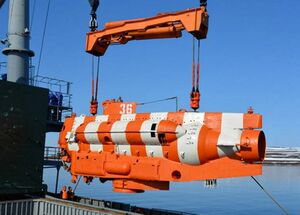Sairdhom-class Submarine: Difference between revisions
mNo edit summary Tag: 2017 source edit |
mNo edit summary Tag: 2017 source edit |
||
| Line 66: | Line 66: | ||
====Service History==== | ====Service History==== | ||
[[File:АС-34 - Испытательные погружения экипажей глубоководных спасательных аппаратов Северного флота 02.jpg|thumb|Sairdhom-04 prior to a salvage dive, [[Kilikas Sea]] c. 2024]] | |||
==See Also== | ==See Also== | ||
Revision as of 01:07, 17 January 2024
The Sairdhom-class Submarine, formally the SH-1992-2 Deep Sea Support Vessel, is a class of Deep Sea Rescue Vehicle operated by Faneria and Brumalea. Its primary tasks are underwater repair, salvage, and rescue; a classified intelligence variant is known to exist but it is believed to be at most two vessels. There are currently eighteen of the civilian variant operated globally, with a redesign of the same general layout planned for production by 2030. Of the eighteen in service, one is owned by Brumalea, seven are owned by corporate entities or private firms, and the remaining ten are operated by Faneria. Six of Faneria's are active; the others are mothballed.

| |
| Class overview | |
|---|---|
| Name: | TSH-1992-2 DSRV |
| Operators: | Fhainnin National Army |
| Built: | 1995–present |
| In service: | 1996–present |
| Completed: | 19 |
| Active: | 14 |
| Laid up: | 4 |
| Retired: | 1 |
| General characteristics | |
| Type: | Deep Submergence Rescue Vehicle |
| Displacement: | 55 tonnes (54 long tons) |
| Length: | 13.5 m (44 ft 3 in) |
| Beam: | 3.8 m (12 ft 6 in) |
| Height: | 4.6 m (15 ft 1 in) |
| Speed: |
|
| Range: | 22 nautical miles (40 km) |
| Endurance: |
|
| Test depth: | 1,000 m (3,300 ft) |
| Capacity: | 20 passengers |
| Crew: | 4 |
History
Design
The name 'Sairdhom' is a shortening of 'Teasairdhom', itself a contraction of 'deep rescue' in Fhasen. Originally envisioned as a class of rescue vessels numbering no more than one or two, the Sairdhom was meant as an auxiliary vessel to the Fhainnin navy, acting as a black-box or, in rare instances, sailor recovery vehicle for submarines. However, as a result of increased funding and delays due to technology updates and role creep, the design eventually was bulked out to twice its original planned displacement, becoming the flagship design for deep-sea civilian vehicles in Faneria.
Production
Service History
